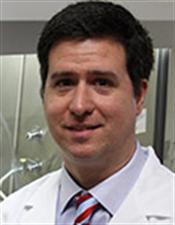UR Medicine was selected to be a part of the Pulmonary Fibrosis Foundation Care Center Network to expand care and research into pulmonary fibrosis, also called lung scarring. UR Medicine Pulmonary Division is recognized as an international leader in lung disorders, including pulmonary fibrosis.
"Over the past decade, the clinical faculty and staff have worked hard to develop an outstanding care team for our patients with fibrotic lung disease and being recognized in this way will no doubt raise awareness of these sometimes devastating lung diseases," said Paul Levy, M.D., chair of the Department of Medicine. "Having the Pulmonary Division designated as a Pulmonary Fibrosis Foundation Care Center Network site is a great achievement."
Pulmonary fibrosis has several forms, some of which are treatable. However, idiopathic pulmonary fibrosis is particularly difficult to treat and there is no cure. Pulmonary fibrosis is diagnosed when lung tissue becomes thickened, stiff, and scarred. The development of the scar tissue is called fibrosis, and as it progresses, the lungs thicken and are unable to transfer oxygen into the bloodstream causing shortness of breath. As a result, the brain and other organs don't receive enough oxygen.

In some cases, doctors can determine the cause of the fibrosis, but in many cases, there is no known cause, and the disease is called idiopathic pulmonary fibrosis or IPF. There is no cure for IPF, though recently the FDA approved two new therapies.
This disease affects about 200,000 Americans each year. There are other treatable forms of lung fibrosis, however idiopathic pulmonary fibrosis is particularly difficult to treat.
"We are honored that the Pulmonary Fibrosis Foundation has recognized the quality of our programs and the expertise our medical staff have in treating patients with fibrotic lung disease," said Patricia Sime, M.D. F.R.C.P., chief of the Division of Pulmonary and Critical Care Medicine. She is an authority in the field of pulmonology best known for her basic and translational research of lung inflammation and scarring.

Sime, R. Matthew Kottmann, M.D., and Michael Kallay, M.D., lead the Interstitial Lung Disease Clinic, Upstate New York's only program selected for the national network dedicated to advancing care and research. It is one of 40 top centers in the nation, allowing scientists and pulmonologists to collaborate on studies and patient care.
UR Medicine's multidisciplinary team provides comprehensive care for pulmonary fibrosis, sarcoidosis, silicosis and other lung diseases, including diagnosis, treatment, symptom and side-effect management, supportive services, and genetic testing.
Funded primarily by the National Institutes of Health and foundations the clinicians and scientists also lead industry-supported research into cures. Sime, Kallay and Kottmann, along with Richard Phipps, Ph.D., lead innovative clinical studies into new therapies and basic science laboratory investigations to advance understanding of these diseases.